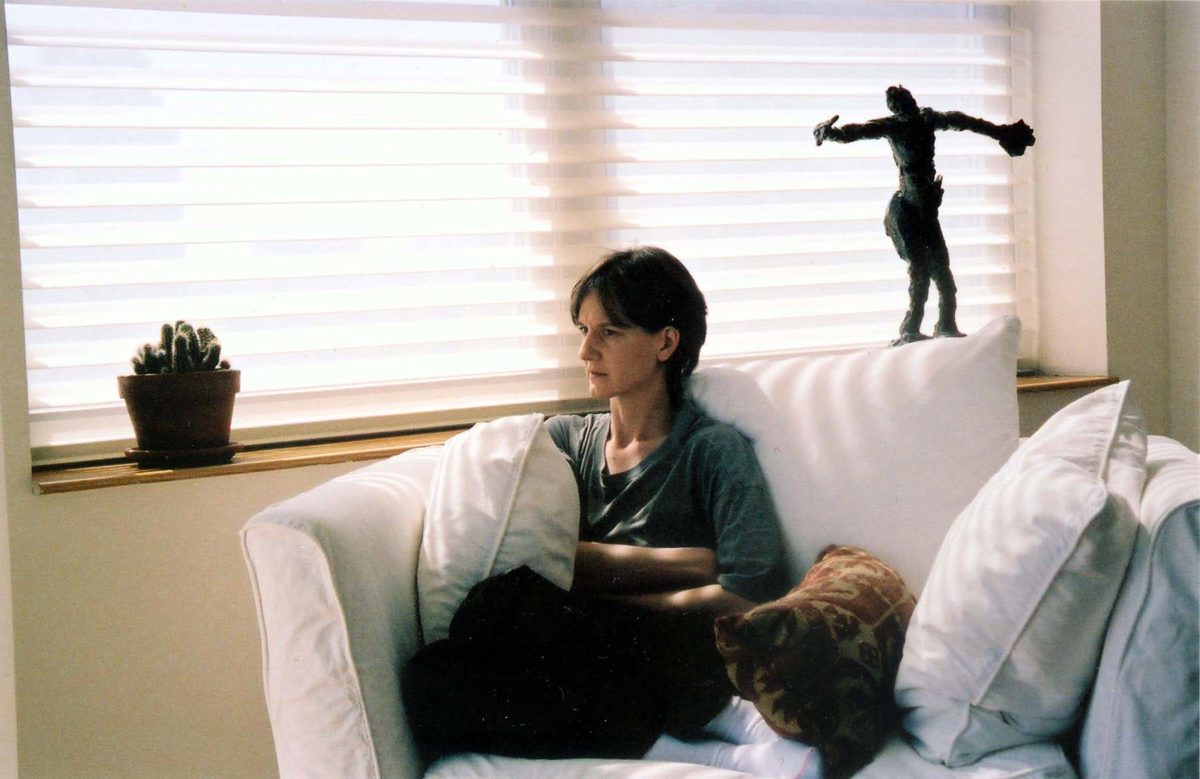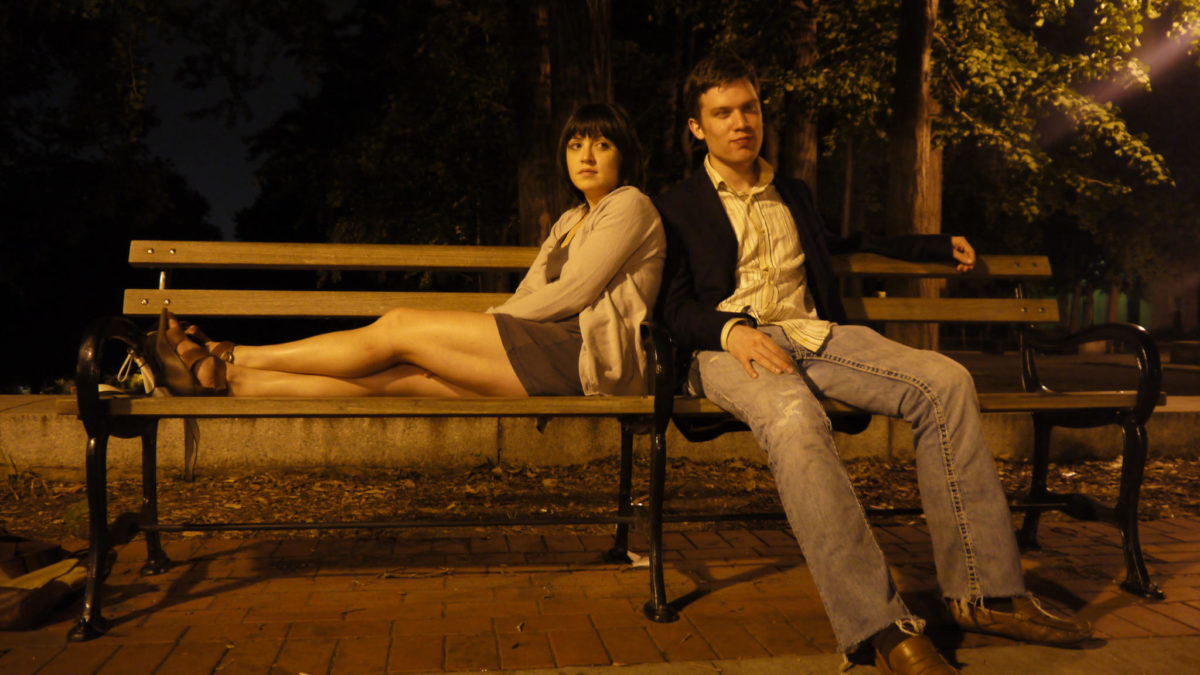A phone rings. With a burdened sigh, kindergarten teacher Mara (Tallie Medel) answers to a monologue unspooling on the other side of the line, a call for help, which, it seems, judging by the discreet wrinkle on her forehead, is not a one-off thing. Leaving one (actual) kid to attend to another, her childhood friend Jo (Norma Kuhling), Mara is portrayed as the gravitational centre of a long-term friendship, whose orbit Jo spun in and out of through the years. Dan Sallitt’s Fourteen (2019) starts off as the story of a particular friendship’s oddities, but its layered psychological structure touches on a universal truth about the enigmatic nature of intimacy.
Many films claim to capture the authenticity of human experience through a crux, a dramatic spin, or a trauma; to a large extent, art house cinema has explored so many of the facets of everyday life, especially those that link it to the extraordinary. For example, Richard Linklater’s epic explorations of time passing and its effect on human relationships have branded him as a master of representing the art of discourse—devoted “Before” trilogy fans would vow to the film’s authenticity in portraying their own thoughts and conversations. Within Linklater’s generation, one even more expressive and deeply transformative director deserves our attention: Dan Sallitt, who has produced a singular body of work over the course of several decades devoted to both filmmaking and film criticism. His four previous features, Polly Perverse Strikes Again (1986), Honeymoon (1998), All the Ships at Sea (2004) and The Unspeakable Act (2012), are now crowned by his latest, Fourteen (2019), which epitomizes Sallitt’s emotional intelligence as a director together with his critical mind-set, guiding the viewer’s humanist sensibility to the painful gaps where it’s most needed. His distinctive style—precise framing, long takes capturing seemingly mundane episodes, toned-down colour scheme and minimal sound—tunes down the background, allowing complex characters, impeccably portrayed by the actors, to dig into their own psyche so deep, that even skeptics would concede to the existence of a soul.
Sallitt’s oeuvre could be called the love child of Éric Rohmer and Howard Hawks: the former known for his idiosyncratic conversational style that through dialogue and gestures brings emotions to the forefront rather than propelling action or plot; Hawks, on the other hand, a giant of classical Hollywood cinema who brought us a plethora of films that transcend gender dynamics through verbal pugilism, such as His Girl Friday (1940) or The Big Sleep (1946). Sallitt’s representations of relationships have touchy subjects (familial love, romantic love, forbidden love, friendly love) at their core, to which the audience is introduced in a decisive moment usually subdued by mundane circumstances: in Honeymoon, Mimi and Michael decide to get married after years of friendship and retreat to a lake house; in All the Ships at Sea, a runaway sister is reunited with her older sibling in the cottage they both grew up in; The Unspeakable Act captures the summer before Jackie’s brother leaves for college, as she is left to suffer the emptiness of her incestuous desires for; Fourteen spans across years in exploration of an ‘odd pair’ friendship, Mara and Jo, and their gradual fallout. Sallitt’s films are micro-budget and fulfill their emotional ambition by exploring the ambivalent concept of love as “a trap and a way out”, as he himself describes it, and ‘love’ and ‘family’ seem to be interchangeable in the context of his films, all controversies included.

Fourteen
Of the two friends, it seems only Mara is attempting to master the art of growing up. While Fourteen mostly sticks to her perspective, keeping to her side of the telephone talks and rarely showing Jo on her own, it nevertheless traces out both characters’ imperfections and focuses on the ways they fit together in long takes of their interaction. Portrayed by a tracking shot as they are strolling through the streets of Brooklyn, one sequence records their loopholed conversation. Jo is dating a guy, “some kind of artist of musician”, that drives her insane but “he’s cool”. Chain-smoking and discussing yet another man in her serially monogamous life, Jo disappears into a shop “to get a brownie”, leaving Mara in a disoriented monologue. Norma Kuhling’s renegade boho-style looks fit perfectly with her negligent tone, to form the enigmatic image of Jo as a “basket case”, a troubled young woman that is characterized not by introspective comments or self-reflection, but by her failed jobs, dissolving relationships, and violent outbursts. Yet, in the maternal eyes of tenderhearted Mara, Jo exists as a hedonistic goddess, an attractive combination of flaws and idealism that give colour and vibrancy to an otherwise grey life. Positioning the two women next to each other when talking, either against a wall or on the street, the camera highlights their differences in look (Joe is tall and skinny, Mara significantly shorter); alternatively, when framed in a close-up, their faces have the same antipodal relationship—Mara’s compassionate face is the antidote to Jo’s strong chin and the stubbornness it alludes to. Tallie Medel is the brightest gem in the clique of actors and actresses Sallitt usually works with; her remarkable performance in The Unspeakable Act remains an exquisite example of depicting intricate trauma. Here, Medel plays the stronger half of the friendship, psychologically fit to take on adult life, yet her vulnerability comes to the forefront when confronting her mentally unstable best friend. Jo and Mara both bicker and compliment each other as any big on-screen couple, aligning all hardships of friendship and familial love to weave the mysterious compatibility and devotion that brings them together. Unfortunately, as in life, the same enigma that binds a couple together, often becomes what makes them fall apart later on.
Fourteen, which denotes the age the protagonists started their friendship, always alludes to a past but in its narrative is contained within the classic idea of drama as unity of time, space, and action, even when the episodes are years apart. The shooting schedule of the film was organized around the director’s availability (Sallitt has always funded his own films and has to find ways around his full time job to make them), and criticism of the punctured narrative seems very inappropriate in a case where story unfolds in a unified manner, every part of the film an entity of its own, contributing to its emotional excavations. Its path is never smooth; it goes over high peaks (outbursts of dialogue when it builds up to enlightened accusations and their touching defenses) and across flat plateaus. One sequence in particular arrests the narrative in the film’s middle, stretching into a timeless moment: commuters disembarks a train at a station, a bird’s eye view of the people getting off and going about, a static camera that lingers in its omniscient viewpoint high above daily life in its banality, and ultimately, in its inevitable flow. As much as Sallitt’s films capture an unarticulated trauma, and however much his protagonists struggle to explicate their distress, whether in a theology dispute (All the Ships at Sea), in a therapist’s office (The Unspeakable Act), or in a frigid bedroom (Honeymoon), the films construct their own crystal clear grammar, precisely framing profound dialogue that ultimately has to be channelled into everyday acts.

Conversations
As they talk, Sallitt’s characters perform a specific kind of logotherapy on each other, being equally strong, opinionated, and complimentary in their disagreements. Their topics of conversation are expansive. Take for example the discussion on the nature of faith in All the Ships at Sea, in which two sisters, Catholic professor Evelyn and her renegade sibling Virginia, who now belongs to a religious sect, verbally battle over heavy theological themes, using arguments pro and contra God’s existence and the essence of faith in a manner similar to medieval philosophical debates. In a beautiful cottage filled with family history, the recently returned Virginia (Edith Meeks) remarks how the radio plays the same songs it did when she and Evelyn (Strawn Bovee) were children. The radio serves as a time capsule, a reminder of a past that is available only through stories. Indeed, retrospection and flashbacks are not Sallitt’s preferred choice in approaching the past, which makes his filmmaking style more verbal (as the characters only talk about the past, subjectively), and present (in the Aristotelian unity of time, space, and action). Even though his characters are unafraid to tackle heavy ethical and theological topics, delivered with great levity and flow by the actors, their expansive, profound dialogue always succumbs to its quotidian confines. As far as one can venture into discussions about abstract concepts and their rationalization, everyday life always catches up. Life, in its painstaking persistence, carries on, and even an existentially earth-shattering event is not isolated from the demands of the quotidian (e.g. In Fourteen, grief over loss cannot absolve you from keeping your child fed). Balancing on top of this juxtaposition, Sallitt’s meditative films bring cinema closer to the course fabric of life.

Humanism
Nevertheless, none of his films are pessimistic. It requires a great degree of humanism and empathy to keep the bleakness of life’s troubling ways in close proximity to the sublime. Sallitt loves films and people, as evident from his ever-expanding cinephiliac list, ‘Dan Sallitt’s Favorite Films’, and his work with actors who deliver vivid performances in lengthy dialogues and facing a lack of melodramatic action. His characters say what they feel and gesture towards what the other should be feeling. Physical contact is a marker of utmost understanding and a goal that’s difficult to achieve. In Honeymoon, Mimi (Meeks again, this time softer) and Michael (hunky and quiet Dylan McCormick) aspire to a romantic purity by not consummating their relationship before they get married. Long-time friends, they hope that the comfort of emotional intimacy will guarantee their sexual compatibility. Alas, the film explores how wrong they were to assume it. Alternating between long living room talks and bedroom scenes with barely any dialogue, Sallitt alludes to the ineffable, which will be the thematic core in his later project, The Unspeakable Act. Honeymoon confines what cannot be said to the minefield of sexual dysfunction. The ambivalent combination of romantic intimacy and its impossible physical externalization (i.e. sex), is the frustrating core of this chamber-drama.
One could argue that the distance between people is the main drive and impetus of Sallitt’s films, as the protagonists are fiercely striving to overcome that distance. Mimi and Michael live tacitly, sweeping the issue under the rug until their relationship starts to crumble. In a severe tragic sense, the film’s self-contained emotion resembles Bergman’s Scenes from a Marriage (1973). In both films, the protagonists are guided by an overpowering tenderness for each other, which can take painful shapes and forms, although in it shines the Romantic idea of feeling above rational thought. Art theorist Friedrich Schlegel defined Romanticism as “depicting emotional matter in an imaginative form”. Imagination is a unifying device that brings together those matters of the heart that people (and fictional characters) have trouble voicing. Whether about sexual dysfunction, issues of faith and disbelief, questions of incest and taboo, Sallitt’s films exemplify the therapeutic power of empathy, which is visually enacted by shot-counter-shot compositions and lingering close-ups of faces.
In his works so far, masterfully summarized in Fourteen, Sallitt delivers both characters and audiences from the inarticulate, traumatic stasis, in a moment of epiphany, an insight close to the psychoanalytic use of the word, that manifests repressed emotions into an articulate form. In his films, this insight is portrayed as an emotional breakdown in which the tears are ones of liberation. While the protagonists experience this liberation as a collision of force fields, the cathartic impact on the audience is mediated by the films’ stylistic consistency, which mimics the safeguard of daily routines. In an unobtrusive manner, the set design, scarce use of music, crisp cinematography and faded colour scheme emphazise the emotional perturbation that remains muffled by the bleakness of everyday rituals. For the outside world, the only sign that The Unspeakable Act’s Jackie is depressed, is that she stops eating, missing the daily family meals. In Fourteen, Jo emerges in Mara’s life from time to time, only to introduce her to a new boyfriend in a “third-wheel” scenario over dinner or drinks. Repetitions of social rituals form a thick layer of everyday life, which becomes the canvas for Sallitt’s characters’ transformation. While not a metamorphosis, the change that all the couples undergo is one of reconciliation, by bringing an incomprehensible trauma to light and articulation, so they can engage in quotidian activities anew.
Based on the four words for ‘love’ in Ancient Greek, C.S. Lewis distinguishes four loves; one could link their conceptual similarities to the way Sallitt approaches relationships in crises. Family love or empathy (storge) is one that is encountered without any preconditions, it is “ready-made”; the incestuous variation of this love affects Jackie in The Unspeakable Act in an ambivalent way. The friendship bond (philia) is a freely chosen love that is rooted in companionship and endurance over time; Fourteen traces out the mechanisms of a long-lasting friendship and never questions its foundations, making it explicit that Mara chooses to be Jo’s best friend. When she exceptionally decides not to honor her friendship, it only affirms the rule of free will in maintaining this companionship. The erotic bond (eros) is attuned to physical pleasures and holds dangers to people who submit themselves fully to hedonism and delights of the flesh; in Honeymoon, the couple attempts to have a pure relationship, stepping into marriage before sexual contact, which provides the traumatic obstruction to their romantic life. Striving to reach a balance with regards to eros, Mimi and Michael’s marriage is on the verge of collapse. The fourth kind of love is, in accordance with C.S. Lewis’ religious thinking, unconditional (agape). Like the love of God for His people, agape is abstract and non-definable. When Virginia returns home after living in a religious commune that worships super-human entities, her Catholic sister is confronted with a crisis of her own faith. The lengthy dialogues about doctrines and theology reveal that the real bearer of unconditional love and faith is the unorthodox Virginia, while the ferocious Catholic Evelyn has to face the crumbling of her self-image. Fitting profound realizations in the cracks between the mundane elements of daily life, the films of Dan Sallitt turn a family, a couple, or a friendship, into a emotionally resonating microcosm bearing universal significance.
